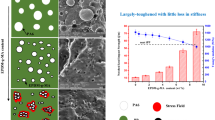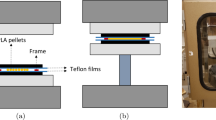Abstract
In this paper, the creep behavior of molybdenum disulphide (MoS2) filled polyamide 66 composite was investigated through sharp indentation at room temperature. Two types of indentation creep test, the 3-step indentation test, and the 5-step indentation test were considered in order to explore whether the measured creep response is mainly viscoelastic or includes a significant contribution from the plastic deformation developed during the loading phase. The experimental indentation creep data were analyzed within an analytical framework based on the hereditary integral operator for the ramp creep and a viscoelastic–plastic (VEP) model in order to determine the indentation creep compliance function including the short- and long-time modulus. The equivalent shear modulus calculated from the creep compliance function was compared to the indentation plane strain modulus derived from the initial slope of the unloading curve in order to investigate the validity of the Oliver and Pharr method.













Similar content being viewed by others
References
Bernard, C., Keryvin, V., Sangleboeuf, J.C., Rouxel, T.: Indentation creep of window glass around glass transition. Mech. Mater. 42, 196–206 (2010)
Briscoe, B.J., Fiori, L., Pelillo, E.: Nano-indentation of polymeric surfaces. J. Phys. D, Appl. Phys. 31(19), 2395–2405 (1998)
Chicot, D., Mercier, D.: Improvement in depth-sensing indentation to calculate the universal hardness on the entire loading curve. Mech. Mater. 40, 171–182 (2008)
Chudoba, T., Richter, F.: Investigation of creep behaviour under load during indentation experiments and its influence on hardness and modulus results. Surf. Coat. Technol. 148, 191–198 (2001)
Doerner, M.F., Nix, W.D.: A method for interpreting the data from depth-sensing indentation instruments. J. Mater. Res. 1(4), 601–609 (1986)
Fischer-Cripps, A.C.: Nanoindentation, 2nd edn. Springer, New York (2004)
Kermouche, G., Loubet, J.L., Bergheau, J.M.: Extraction of stress–strain curves of elastic–viscoplastic solids using conical/pyramidal indentation testing with application to polymers. Mech. Mater. 40, 271–283 (2008)
Huang, G., Lu, H.: Measurements of two independent viscoelastic functions by nanoindentation. Exp. Mech. 47, 87–98 (2007)
Lee, E.H.: Stress analysis in viscoelastic bodies. Q. Appl. Math. 13, 183–190 (1995)
Lee, S., Knauss, W.G.: A note on the determination of relaxation and creep data from ramp tests. Mech. Time-Depend. Mater. 4, 1–7 (2000)
Lee, E.H., Radok, J.R.M.: The contact problem for viscoelastic bodies. J. Appl. Mech. 27, 438–444 (1960)
Lu, H., Wang, B., Ma, J., Huang, G., Viswanathan, H.: Measurement of creep compliance of solid polymers by nanoindentation. Mech. Time-Depend. Mater. 7, 189–207 (2003)
Mencik, J., He, L.H., Swain, M.V.: Determination of viscoelastic–plastic material parameters of biomaterials by instrumented indentation. J. Mech. Behav. Biomed. Mater. 2, 318–325 (2009)
Oliver, W.C., Pharr, G.M.: An improved technique for determining hardness and elastic modulus using load and displacement sensing indentation experiments. J. Mater. Res. 7(6), 1564–1583 (1992)
Oliver, W.C., Pharr, G.: Measurement of hardness and elastic modulus by instrumented indentation: advances in understanding and refinements to methodology. J. Mater. Res. 19, 3–20 (2004)
Oyen, M.L.: Spherical indentation creep following ramp loading. J. Mater. Res. 20(8), 2094–2100 (2005)
Oyen, M.L.: Analytical techniques for indentation of viscoelastic materials. Philos. Mag. 86(33), 5625–5641 (2006)
Oyen, M.L., Cook, R.F.: Load–displacement behavior during sharp indentation of viscous–elastic–plastic materials. J. Mater. Res. 18, 139–150 (2003)
Radok, J.R.M.: Visco-elastic stress analysis. Q. Appl. Math. 15, 198–202 (1957)
Sakai, M., Shimizu, S., Miyajima, N., Tanabe, Y., Yasuda, E.: Viscoelastic indentation on iodine-treated coal tar pitch. Carbon 39, 605–614 (2001)
Sneddon, I.N.: The relation between load and penetration in the axisymmetric Boussinesq problem for a punch of arbitrary profile. Int. J. Eng. Sci. 3, 47–57 (1965)
Vandamme, M., Ulm, F.J.: Viscoelastic solutions for conical indentation. Int. J. Solids Struct. 43(10), 3142–3165 (2006)
Vandamme, M., Tweedie, C., Constantinides, G., Ulm, F.J., Van Vliet, K.: Quantifying plasticity-independent creep compliance and relaxation of viscoelastoplastic materials under contact load. J. Mater. Res. 27(1), 302–312 (2012)
Zhang, C.Y., Zhang, Y.W., Zeng, K.Y., Shen, L.: Characterization of mechanical properties of polymers by nanoindentation tests. Philos. Mag. 86(28), 4487–4506 (2006)
Acknowledgements
This work was supported by Executive Agency for Higher Education, Research, Development and Innovation Funding (CNCSIS-UEFISCDI), Project number PNII–IDEI 788/2008. In addition, the authors are grateful to Loredana Santo from Tor Vergata University of Rome (Italy), who kindly provided access to the testing equipment.
Author information
Authors and Affiliations
Corresponding author
Rights and permissions
About this article
Cite this article
Stan, F., Fetecau, C. Characterization of viscoelastic properties of molybdenum disulphide filled polyamide by indentation. Mech Time-Depend Mater 17, 205–221 (2013). https://doi.org/10.1007/s11043-012-9198-5
Received:
Accepted:
Published:
Issue Date:
DOI: https://doi.org/10.1007/s11043-012-9198-5




